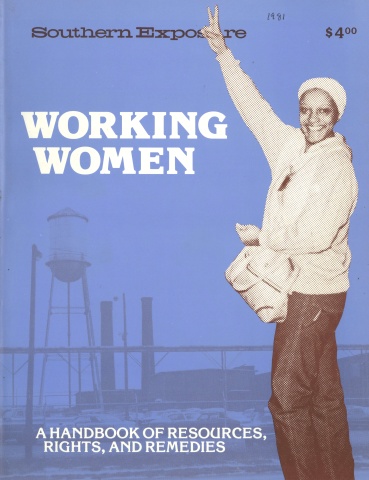
This article originally appeared in Southern Exposure Vol. 9 No. 4, "Working Women: A Handbook of Resources, Rights, and Remedies." Find more from that issue here.
Most untrained black women in the sugar cane country of south Louisiana have three career choices. They can be housekeepers or work in day-care centers. Or they can remain on the plantations planting and scrapping sugar cane, the seasonal, back-breaking hand work considered “women’s work.”
Ethel Gray was given another choice — and she took it. Today, only five years away from the cane fields of the Rosebud Plantation in Baldwin, Gray is a skilled carpenter and community organizer. The change in Gray’s life began in 1976 when she signed on as a VISTA volunteer to the Southern Mutual Help Association in Jeanerette.
“I needed that money,” Gray recalls. “I had three children, my husband was gone and the job was regular. It was better than nothing.” It was better, she adds, than returning to Rosebud, where she had spent the first 25 years of her life.
Gray became a participant in SMHA’s youth training program. She learned to manage money, look for jobs, fill in applications, handle a job interview and, to her surprise, build homes. She was assigned to Wallace Poullard, a skilled carpenter with the self-help housing project, who was to teach her carpentry.
“At first it was very hard. All I kept thinking was: ‘This is men’s work.’ But he kept pushing me. I kept saying I can’t and he kept saying I can.”
Poullard took the reluctant apprentice on a tour of the homes being constructed. Most of the building was behind schedule. Still considering the work “men’s work,” and grumbling under her breath, Gray went to work beside the other carpenters.
“Some kind of way we had to finish those houses,” she says. “We went to each house to see what needed to be done. We worked on one house after another, and Mr. Poullard, a good teacher, he kept telling me one day I was going to have to take over. Well ... I would laugh at that!
“The main thing about the job, once you learn how to frame up, is reading the ruler, using the tools. I developed blisters cause I didn’t know how to use a hammer. I knew it was men’s work, for sure, when I saw those blisters! Mr. Poullard, he say I was just holding that hammer wrong, holding it too tight. After that I didn’t have blisters again.
“One day Mr. Poullard say, today we gonna use the gun. Well, I didn’t know what he was talking about. I just looked at him like he was nuts when he told me, ‘Go get the gun in the truck.’ ‘I don’t fool with no gun,’ I told him. He say, ‘Girl, not that kind of gun. It’s a gun to drive nails into the cement and you gonna shoot it yourself.’ When I finally tried it I kinda liked it. I started laying out one room after another and Mr. Poullard he say, ‘I’m gonna leave you to do this house alone.’”
In the midst of finishing the first nine houses, and with six houses yet to build, Poullard suffered a stroke and was unable to return to work. Gray became a supervisor. She was confident. She knew what she was doing and enjoyed her work. But the new position brought with it a new problem.
“I’d go to the lumber yard to order materials and the manager, he tried to confuse me. I’d say I want this and he’d try to give me something else, something I didn’t need. Like one day I said I needed baseboard molding and shoe molding. He said I didn’t need shoe molding, asked me what I was gonna do with it. I had to explain in detail how I was gonna use it. . . . He didn’t want to fill that order. He said he wanted the approval of the male supervisor. I told him I was a supervisor and finally he took the order, but he shook his head, saying, ‘I don’t believe this!’
“Then he came out there on the site to really see what we were doing. He come up to me later and he say, ‘You can get a job working for me anytime.’ I believe him!”
Tags
Carolyn Portier
Carolyn Portier is a free-lance writer from south Louisiana. For the past three years she has lived in the North Carolina mountains, where she managed and edited her own farm paper. (1981)

